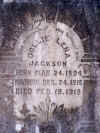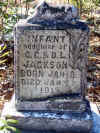Nimrod Jackson
Reprinted from the
February 25, 2010, edition of "The Georgia Post."
Crawford
County’s Nimrod
Jackson
found after 144 years
By
Billy Powell
Billy Powell, from Fort Valley, is a newspaper
journalist and the author of four books. He loves to research and write about
local history.
Byron
Flag Stop named after Nimrod
Jackson
Nimrod Jackson (1795-1866) was a
distinguished Crawford Countian. In 1850, some 160 years ago, Nimrod was honored
by the Southwestern Railroad. The
flag stop at Byron was named after him and called “Jackson Station.”
Although Nimrod’s surname initially applied to the railroad flag stop,
the settlement there became known as “Jackson Station.” The town was
officially named Byron in 1874.
The
Search for Nimrod
Jackson
The location of
Jackson
’s burial site, although known to his generation, was forgotten with the
passage of 144 years since his death. For the past several decades, numerous
attempts have been made by
Peach
County
historians and
Jackson
’s descendants to find Nimrod’s cemetery, but with no success. There were no
clues other than the belief that he was likely buried on his land in eastern
Crawford
County
. Based on his land holdings on courthouse records, this would place his
cemetery somewhere between Byron and the
Bibb
County
line. Being such an expansive area, no one seriously expected to find Nimrod
Jackson’s grave. For all intents and purposes, it was a closed case until
Crawford
County
historian Sidney Goodrich got into the act. Among
Sidney
’s collection of maps was one that identified the locations of 139 cemeteries
in
Crawford
County
. As Sidney and I scanned the map
index, we spotted the
Nimrod
Jackson
Cemetery
. It was identified as site Nr. 15 in a section of eastern
Crawford
County
that bordered
Peach
County
in the south and
Bibb
County
in the north. The cemetery was marked at the point where
Jordan Road
intersects
Scout Road
. This locale proved to be in error--the
Crawford
County
map needs changing!
Nimrod
Jackson
Cemetery
Found
This writer conducted a search of
the above mentioned area on February 11, 2010. Driving
north of Byron on
Scout Road
and finding nothing resembling a cemetery at the
Jordan Road
intersection, he drove further north to the
Holcomb Valley Road
intersection. No cemetery was obvious in that area either. Equally discouraging
was the fact that the residents along
Scout Road
had never heard of Nimrod Jackson, much less his cemetery. After driving
northward to the bridge at the
Bibb
County
line, I turned around and headed back to Byron.
As I drove south down
Scout Road
, I noticed a narrow clay road leading up an incline into a pine thicket. I
decided to make one final search, before calling it a day. As I drove to the top
of the hill, there on my left and inside the woods was a cemetery covered in
undergrowth. I exited the car and excitedly started checking the graves for
inscriptions. Some graves appeared
to be over 100 years old, but they were unmarked.
My heart jumped with joy when I found that the graves that did bear
inscriptions carried the surname “
Jackson
.” Nimrod Jackson’s cemetery had been found! Had this ‘one-in-a-million’
final search not produced positive results, I would have given up and returned
home.
Directions
to
Nimrod
Jackson
Cemetery
Nimrod Jackson’s cemetery is
located approximately one-half mile north of the
Holcomb Valley Road-Scout Road
intersection. It’s on the east side of
Scout Road
, about 150 feet off the highway. You must drive up an incline leading into the
woods. Directly behind the cemetery
is the home of Chuck and Callie Pittman (unseen from
Scout Road
), who own a landscaping business on
Hartley Bridge Road
.
Nimrod
Jackson endeared himself to Southwestern Railroad
The saga of Nimrod Jackson goes
back to the 1840s when the Southwestern Railroad was built from
Macon
to Echeeconee and then to Byron and Powersville and on to
Fort
Valley
. Since the railroad had already
named Echeeconee as Station Nr. 1 and Powersville as Station Nr. 2, the Byron
flag stop was given the intermediate designation of Station “Number One and
One-Half.” When the rail line became operational during the late 1840s, Nimrod
Jackson began maintaining a wood rack to resupply the wood-burning locomotives
that stopped there. His wood rack, surrounded by a dense forest with only a
narrow road leading to and fro, stood north of the present Byron depot, not
there during Nimrod’s day and not built until the 1870s.
In 1850, because of
Jackson
’s loyalty and service to the fledging railroad, the flag stop was named
“Jackson Station” in his honor.
Brief
History of Byron
The settlement there began to
grow in 1860 when William Hays built a general merchandise store that was
operated by Seaborn Hartley. That same year a post office was established.
In 1867, a second store was erected by Dr. C. H. Richardson, a native
South Carolinian, who became Byron’s first mayor.
By 1870 a number of homes and cottages had been erected near the downtown
area with the area’s total population edging toward 300.
The townspeople wanted to name the settlement “Richardsonville” after
the beloved Dr. Richardson, but
Richardson
opted to name the town Byron, after the famous Brittish poet, Lord George
Gordon Byron (1788-1824). In 1874, the town was officially named Byron by an act
of the Georgia Legislature. Byron remained a part of
Houston
County
until
Peach
County
became
Georgia
’s 161st county on January 1, 1925.
Peach
County
was created from parts of
Houston
and
Macon
Counties
through a constitutional amendment approved by the Georgia General Assembly on
18 July 1924. The constitutional amendment was ratified by
Georgia
voters on 4 November 1924 by vote of 77,052 to 31,211.
Biographical
Sketch of Nimrod
Jackson
Nimrod Jackson was born October
22, 1795, in
South Carolina
. He married Elizabeth Busbee
(1792-1879) in 1814 and they settled in
Crawford
County
. Their union produced 12 children: Parmelia, Martha, Felder, Mitta, Ebenezer,
Eliza, William, Elizabeth, John, Rabun, Perry, and Green. Nimrod was a large
property owner and owned land along the railroad. He also was a great hunter,
who hunted with the Creek Indians, particularly Chief William McIntosh
(1775-1825). Legend has it that Nimrod acquired land from the Indians in
exchange for a cow and a calf. Some historians say that Chief William McIntosh
gave Jackson all the territory comprising Houston County, but we have no way of
confirming this. History does record, however, that Indian braves killed Chief
McIntosh because he gave away so much land.
Nimrod Jackson fought in the War of 1812 under Captain John Lee and
Captain Benjamin Frazier of the Georgia Militia. After Nimrod’s death in 1866,
his widow, Elizabeth, was granted a veteran’s pension. Nimrod’s will was
probated in
Crawford
County
on November 5, 1866. According to genealogists on www.genealogy.com, Nimrod was
a cousin of President Andrew Jackson, and they both came from the same area of
South Carolina
. It is interesting to note that numerous descendents of Nimrod Jackson still
live in the Byron and
Crawford
County
areas.
Facts
about
Nimrod
Jackson
Cemetery
:
Nimrod Jackson purchased the land
on which the cemetery resides in 1842. He and his wife, Elizabeth, are buried
there, but their graves are unmarked, and expectedly so, as Nimrod has been dead
for 144 years and
Elizabeth
for 131 years. Nimrod’s great granddaughter, Dollie Lena Jackson, is buried
there, and her tombstone is engraved with identifying information. She was born
in 1894 and died on February 19, 1918. Her infant daughter, buried beside her,
was born January 18, 1918 and died four days later on January 22, 1918. Dollie
Lena’s husband was Crowell Cleveland Jackson (1883-1951) whose parents were
James E. and Sarah Stokes Jackson—another set of
Jacksons
, no known kinship to Nimrod Jackson. Crowell
Cleveland Jackson later married Mary Armanda Kneece; they had four children.
Dollie Lena’s mother and father
were Marion and Mattie Jackson--
Marion
being the grandson of Nimrod Jackson. Marion Jackson’s parents were Felder
and Martha Jackson--Felder being Nimrod’s son, and one of Nimrod’s 12
children. Also said to be buried there are Dollie Lena’s parents, Marion and
Mattie Jackson, and Dollie’s sister—Sallie. The graves of other family
members buried there evidently have sunken into the ground and are covered with
100 years of debris and undergrowth. During the mid to late 1800s, stones and
not cement slabs were often used to mark a grave. Further, several mounds of
dirt in proximity to this site indicated that land clearing has been
accomplished in past years and that some graves inadvertently may have been
bulldozed over.
In
closing, the decades-old search to find the final resting place of Nimrod
Jackson has ended. We now know who
he was, what he accomplished, and where he is buried. We even have a picture of
him, courtesy of his great, great, great granddaughter, Betsy Peavy Murdock of
Byron, Georgia.
My
appreciation to
Crawford
County
historian Sidney Goodrich and genealogist Dwayne Powell, my brother, for their
truly outstanding contributions to the quest to find Nimrod Jackson.
A
huge thanks goes out to Mr. Billy Powell for sharing this information and photos
with us!

At Nimrod Jackson
Cemetery, from left are: Byron Historian Jackie Hays Edwards, Betsy
Peavy Murdock (great, great, great granddaughter of Nimrod Jackson), Bob
Murdock, and Bill
Robertson (second cousin of Nimrod). Bill's brother, former Byron
pharmacist Ben Robertson, not pictured, is also a second
cousin. All are from Byron. |

Nimrod Jackson
and wife, Elizabeth Busbee Jackson, circa 1830.
|

Grave of Dollie Lena
Jackson, great granddaughter of Nimrod Jackson |

Infant daughter of Crowell
Cleveland and Dollie Lena Jackson. Died four days after birth in 1918
|

Jackson Cemetery sits
150 ft. off Scout Road |
This
page was last updated
Monday, March 01, 2010 01:13 PM
Copyright
© Kim Gordon
← Webmaster
All Rights Reserved
Back to Biographies
Back to Crawford County
AHGP